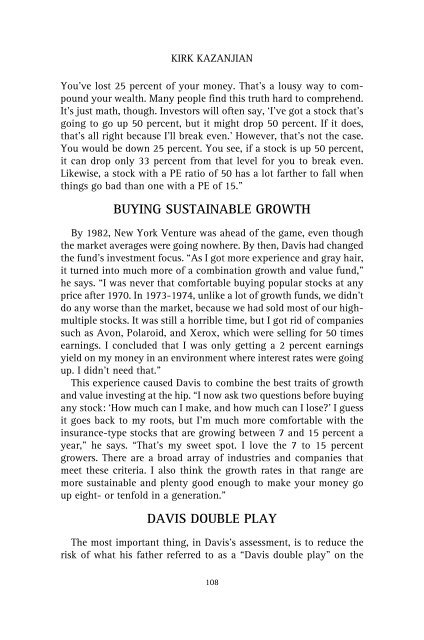Create successful ePaper yourself
Turn your PDF publications into a flip-book with our unique Google optimized e-Paper software.
KIRK KAZANJIAN<br />
You’ve lost 25 percent of your money. That’s a lousy way to <strong>com</strong>pound<br />
your wealth. Many people find this truth hard to <strong>com</strong>prehend.<br />
It’s just math, though. Investors will often say, ‘I’ve got a stock that’s<br />
going to go up 50 percent, but it might drop 50 percent. If it does,<br />
that’s all right because I’ll break even.’ However, that’s not the case.<br />
You would be down 25 percent. You see, if a stock is up 50 percent,<br />
it can drop only 33 percent from that level for you to break even.<br />
Likewise, a stock with a PE ratio of 50 has a lot farther to fall when<br />
things go bad than one with a PE of 15.”<br />
BUYING SUSTAINABLE GROWTH<br />
By 1982, New York Venture was ahead of the game, even though<br />
the market averages were going nowhere. By then, Davis had changed<br />
the fund’s investment focus. “As I got more experience and gray hair,<br />
it turned into much more of a <strong>com</strong>bination growth and value fund,”<br />
he says. “I was never that <strong>com</strong>fortable buying popular stocks at any<br />
price after 1970. In 1973-1974, unlike a lot of growth funds, we didn’t<br />
do any worse than the market, because we had sold most of our highmultiple<br />
stocks. It was still a horrible time, but I got rid of <strong>com</strong>panies<br />
such as Avon, Polaroid, and Xerox, which were selling for 50 times<br />
earnings. I concluded that I was only getting a 2 percent earnings<br />
yield on my money in an environment where interest rates were going<br />
up. I didn’t need that.”<br />
This experience caused Davis to <strong>com</strong>bine the best traits of growth<br />
and value investing at the hip. “I now ask two questions before buying<br />
any stock: ‘How much can I make, and how much can I lose?’ I guess<br />
it goes back to my roots, but I’m much more <strong>com</strong>fortable with the<br />
insurance-type stocks that are growing between 7 and 15 percent a<br />
year,” he says. “That’s my sweet spot. I love the 7 to 15 percent<br />
growers. There are a broad array of industries and <strong>com</strong>panies that<br />
meet these criteria. I also think the growth rates in that range are<br />
more sustainable and plenty good enough to make your money go<br />
up eight- or tenfold in a generation.”<br />
DAVIS DOUBLE PLAY<br />
The most important thing, in Davis’s assessment, is to reduce the<br />
risk of what his father referred to as a “Davis double play” on the<br />
108










